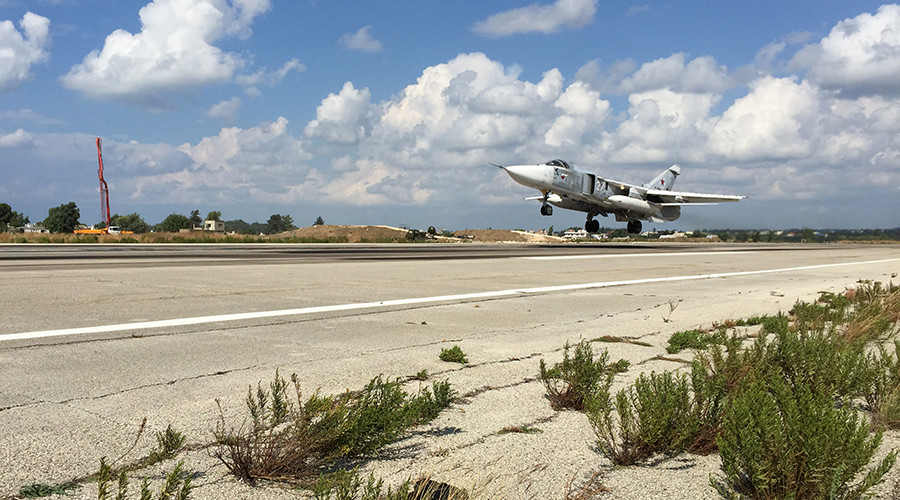"At no time did the [US-led anti-IS] Coalition [in Syria] feel our remotely piloted aircraft were threatened and we expect Russian pilots to act in a responsible, professional manner if they encounter any coalition aircraft. Coalition forces remain focused and committed to our mission to degrade and ultimately destroy ISIL," Baldanza told RIA Novosti on Wednesday.
The statement comes after the Pentagon said at least one American military aircraft was forced to divert its route when flying over Syrian airspace in order to avoid making contact with a Russian warplane, as reported by AP, citing US military spokesperson Naval Captain Jeff Davis.
Davis could not provide any more details, except that some US air operations had had to be changed since Russia began its air campaign. Unconfirmed American media reports also claimed that Russian fighter jets "intercepted" US MQ-1 Predator drones over Syria. Details, however, suggested that the drones' flight paths were not hampered despite close fly-bys.
Comment: Here's how the drone event is being reported in the MSM, courtesy of Fox News:
Russian fighter jets shadowed U.S. predator drones on at least three separate occasions high above Syria since the start of Russia's air campaign last week, according to two U.S. officials briefed on this latest intelligence from the region.
"The first time it happened, we thought the Russians got lucky. Then it happened two more times," said one official.
Both officials said that the incidents took place over ISIS-controlled Syria, including its de facto headquarters in Raqqa, as well as along the Turkish-Syrian border near Korbani. Another occurred in the northwest, near the highly contested city of Aleppo.
The U.S. military's MQ-1 Predator drone is not a stealth aircraft.
"It is easy to see a predator on radar," said one official.
The Russians have not attempted to shoot down any of the U.S. drones, but instead have flown "intercept tracks," a doctrinal term meaning the Russians flew close enough to make their presence felt, according to one official.
One other official said, "the Russians flew very close, but did not impede the drone flight."
Meanwhile, Russia's Defense Ministry said on Wednesday that it had promptly examined an unspecified proposal from the Pentagon on coordination in Syria that the two sides have been discussing, adding that it was possible that this proposal could be implemented.
However, the ministry noted that the US side had been "reducing our coordination only to its technical aspects" such as coordination between pilots during missions. It added that Washington was refusing to share intelligence on IS with Russia, using every possible excuse to avoid cooperation.
In the latest Russian action against IS, four Russian naval warships in the Caspian Sea fired a total of 26 missiles at the terrorist group's positions in Syria on Wednesday.
The Russian weapons were able to reach targets 1,500 kilometers (932 miles) away and all the intended targets were hit, according to Defense Minister Sergey Shoigu.
Following the strikes, the US Commander of North American Aerospace Defense Command (NORAD), Admiral William Gortney, said that Russia's cruise missiles and long-range aviation capability present a new challenge for American defense strategies.
"The challenge that is confronting us...is the Russian long-range aviation and the Russian cruise missile threat from submarine, subsurface platforms and surface platforms," Gortney said in a Wednesday speech at the Atlantic Council.
Gortney added that NORAD and the Northern Command are particularly concerned about this since Russian long-range aviation aircraft are capable of hitting critical targets in North America without ever leaving "Russian territory in order to do it."




These drones fly at a cruising speed of 85 MPH (up to 135MPH) ... The Russians have to be careful not to stall their jets
The unit cost is $20M ... so I can see the temptation to knock of few of them out of the air
Below is USAF Mission statement on the fact sheet for the MQ-1B Drone - [Link]
Seems to be reluctant to be clear that drone missions are to kill people without bothering about trials etc.
"The MQ-1B Predator is an armed, multi-mission, medium-altitude, long-endurance remotely piloted aircraft that is employed primarily as an intelligence-collection asset and secondarily against dynamic execution targets. Given its significant loiter time, wide-range sensors, multi-mode communications suite, and precision weapons, it provides a unique capability to perform strike, coordination and reconnaissance (SCAR) against high-value, fleeting, and time-sensitive targets. Predators can also perform the following missions and tasks: intelligence, surveillance, reconnaissance, close air support, combat search and rescue, precision strike, buddy-lase, convoy/raid overwatch, route clearance, target development, and terminal air guidance. The MQ-1's capabilities make it uniquely qualified to conduct irregular warfare operations in support of combatant commander objectives."